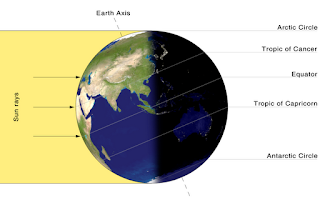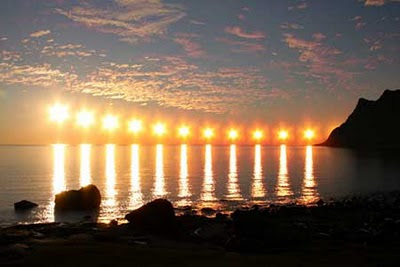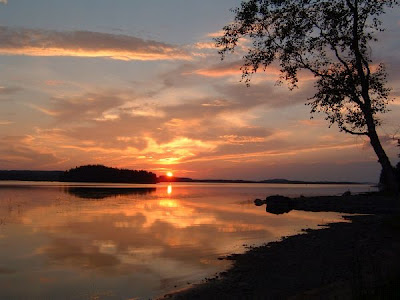The midnight sun is a quite surreal phenomenon happening in very northern or southern latitudes, nearby the polar regions. It is nothing more than having the sun out in the sky, only, at midnight!
What is stunning, though, is that (it depends on the latitude and the season) the sun does not set, but remains still on the horizon before rising again and giving sleepless "nights" to visitors.
[This is a post which is part of the series: 5 unmissable celestial events]
Physical background:
The only reason for this happening every year is found in the geometry of the Earth's orbit around the sun. In this case, a picture is really worth a thousand words.
 |
| Sketch of Earth's revolution around the Sun. The shadow (night) changes through seasons due to the tilt of Earth rotational axis to the ecliptic. |
- The Earth has an almost-circular elliptic orbit around the Sun.
- The Earth rotates about its axis with a period much smaller than the orbital period.
- The Earth's axis is tilted from the normal to the ecliptic plane.
These, apart from being the main ingredients that drive our variate climate, also explain the midnight sunset.
We can make distinction between day and night only thanks to the rotation of the Earth. Frequent travellers certainly know that, depending on the latitude, the sunrise and the sunset times are significantly different in different latitudes (but also with changing season in the same place, of course).
 |
| Sun "apparent" position in different seasons in the Northern emisphere. |
As you can see in the image below, in this situation, there is a zone in which the Earth, is always illuminated from sunlight: the arctic circle. This means that the sun never sets, but approaches more or less (again, depending on the latitude) the horizon and then rise up again.
For the unlucky arctic circle zone in the southern hemisphere, on 21 June the Sun never rises.
Result:
- At the equator, the Sun always rises precisely at east and set at west, which is not true for the other latitudes (they oscillate around east on the sunrise and west on the sunset during the year) and there are 12h of sunlight and 12h of night throughout the year.
- At the equator there are no shadows on the equinox (this happens also at other latitudes in the tropical zone with the extremes at the tropics on the solstices)
- On the equinox (equa nox : equal night) the sun rises at east and sets at west for all the latitudes. Furthermore, there are 12h of sunlight and 12h of night and the sun rise and set at the same time for all the latitudes (apart from the poles). Pretty cool day.
- The solstices are the only days when the sun reaches the lowest inclination in its apparent motion.
- The arctic circles are a strange place. Depending on the latitude (the more near the poles, the weirder) the day/night will lose their significance, since the hours of light are very disproportionate. 24h of sunlight at the summer solstice and 24h of night at the winter solstice.
- The poles, anyway, are the weirdest place: day and night will last half-a-year respectively. The sun will rotate in concentric circles toward the horizon, when on the equinox it will rotate in a full circle while setting for a full day. Stunning.
In addition to these events, a huge number of climate phenomena are driven by the three ingredients.
The midnight sunset is one of the most famous and fascinating events caused by Earth's orbit, for its strangeness and because it is seen in many civilized locations around the north arctic circles.
Locations:
In the arctic circle, particularly: Canada, Alaska, Denmark (Greenland), Norway, Sweden, Finland, Russia, and extremities of Iceland.
The dates vary and strongly depend on the latitude, but it happens around the summer solstice for the north emisphere (21 June). The closer your are to the poles, the wider the range of dates is.
Interesting Links:
Midnight sun in Norway: dates and guide to visit
Very touching photos of the midnight sunset
In case you just need a drink now: the midnight sun cocktail
Update (20/06/2012):
I had to add this stunning picture of a midnight sun during the Venus Transit of 6th June 2012, by Babak A. Tafreshi.




I love to see the sunset over the bali hut perth beach front. Merely looking at it amazes me. Knowing the science behind it is definitely another story. One thing for sure, being amazed is an understatement. Great blog!
ReplyDelete